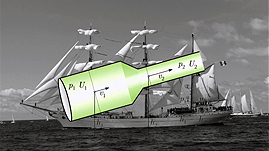Teachers' Domain - Digital Media for the Classroom and Professional Development
User: Preview


Source: QUEST: "The Physics of Sailing"
Modern sailboats function in a way that may seem counterintuitive. When thinking about the sail on a boat, it is logical to assume that the wind is filling the sail pushing the boat in the same direction. In fact, before the modern sailboat was developed in the early part of the 20th century, that is exactly how they functioned. The modern sailboat, however, uses a dramatically different process to move the boat forward.
Believe it or not, the modern sailboat relies on the principle of “lift” to get from one place to another. Lift is an aerodynamic force generated in a direction perpendicular to the flow. In the case of the modern sailboat, the flow is derived from both the wind and the water. Both fluids, air and water interact with the boat to generate lift.
To understand lift, it is important to understand Bernoulli’s Principle. Named for Dutch mathematician Daniel Bernoulli, Bernoulli’s principle states that the speed of a fluid is relative to pressure. When the flow rate of a fluid increases, pressure lowers, and vice versa.
To generate lift, the sail and keel must be able to regulate the flow rate of both air and water. To do this, they must take on a specific, dynamic shape, the same shape of an airplane wing. Air moves over the top of an airplane’s wing much faster than air moving along the bottom. The difference in flow rate produces less pressure above the wing than below, resulting in lift. A sail, when properly adjusted, also takes on this dynamic shape and is thus able to generate lift and pull the boat in a direction that is perpendicular to the flow. The keel below the boat operates in the same way with the water and draws the boat in a perpendicular direction, opposite of the lift generated by the sail.
The two lift forces generated by these two parts of the sailboat can be adjusted so that they counteract each other and generate a forward force in a direction that is a measure of a product of the acting forces. The force generated by the sail is comprised of two parts, a sideways component and a forward component. Similarly, the force generated by the keel has a sideways component opposite that of the sail as well as a forward component. The opposing sideways components cancel each other out, and the remaining forward components propel the sailboat forward.
To learn more about the physics of motion, cehck out Aerodynamics: What Causes Lift? and The Physics of Baseball.
 Loading Standards
Loading Standards